Brief Summary
Reference
-
Andalusian Knowledge Agency (part of The Regional Ministry of Economy, Innovation, Science and Employment), A-TIC-241-UGR18, 01/2020-06/2022, 32.125 euros
"Architecture for IoT networks oriented to environmental sustainability (ARTEMIS)", J. Navarro-Ortiz, 2022
close
@researchproject{artemis, code={A-TIC-241-UGR18}, title={Architecture for IoT networks oriented to environmental sustainability (ARTEMIS)}, org={Andalusian Knowledge Agency (part of The Regional Ministry of Economy, Innovation, Science and Employment)}, type={regional}, author={J. Navarro-Ortiz}, year=2022, month=6, date1={01/2020}, date2={06/2022}, funding={32.125 euros}, url0="http://wimunet.ugr.es/projects/artemis.php", logo="http://wimunet.ugr.es/assets/img/research/projects/agencia_andaluza_conocimiento.png"}
close
Andalusian Knowledge Agency (part of The Regional Ministry of Economy, Innovation, Science and Employment), A-TIC-241-UGR18, 01/2020-06/2022, 32.125 euros
"Architecture for IoT networks oriented to environmental sustainability (ARTEMIS)", J. Navarro-Ortiz, 2022close
@researchproject{artemis, code={A-TIC-241-UGR18}, title={Architecture for IoT networks oriented to environmental sustainability (ARTEMIS)}, org={Andalusian Knowledge Agency (part of The Regional Ministry of Economy, Innovation, Science and Employment)}, type={regional}, author={J. Navarro-Ortiz}, year=2022, month=6, date1={01/2020}, date2={06/2022}, funding={32.125 euros}, url0="http://wimunet.ugr.es/projects/artemis.php", logo="http://wimunet.ugr.es/assets/img/research/projects/agencia_andaluza_conocimiento.png"}
close
This regional project (A-TIC-241-UGR18) is titled "Architecture for IoT networks oriented to environmental sustainability" (ARTEMIS). It started in January 2020 and it ended in June 2022.
Description
This project is focused on the design of a network architecture that allows to collect environmental data from rural (e.g. natural spaces, agricultural and aquaculture farms) and urban (e.g. smart cities) scenarios.
The proposed network architecture is composed of several parts. On the one hand, an LPWAN access network, suitable for mMTC applications. More precisely, we will employ LoRaWAN due to its low-power and large-coverage characteristics. On the other hand, the radio access network and LoRaWAN servers will be communicated over an SDN network. Finally, LoRaWAN servers will be implemented as virtual network functions following the NFV paradigm.
The different solutions developed during this project will be implemented in our LoRaWAN testbed.
Testbeds and repositories
IoT network architecture repository
Implementation for our LoRaWAN-based IoT network architecture using MQTT over multicast through an SDN network used in the paper "A LoRaWAN Network Architecture with MQTT2MULTICAST". Available here. The following picture summarizes the proposed architecture.
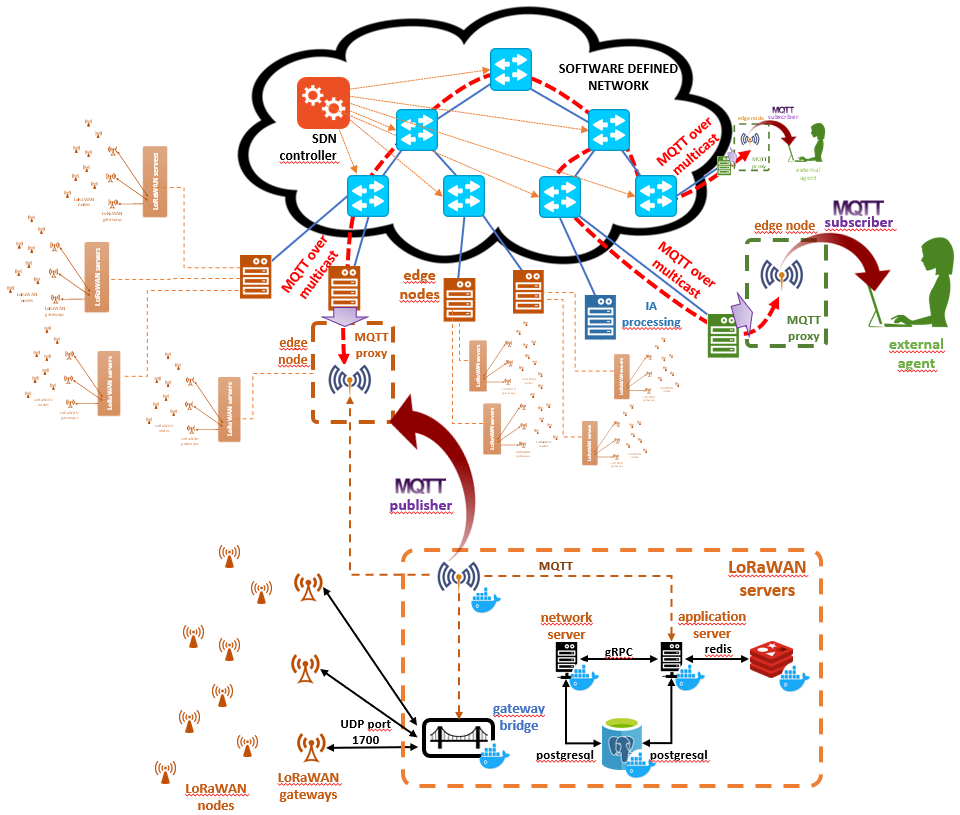
The following picture presents our proof-of-concept for the proposed network architecture.
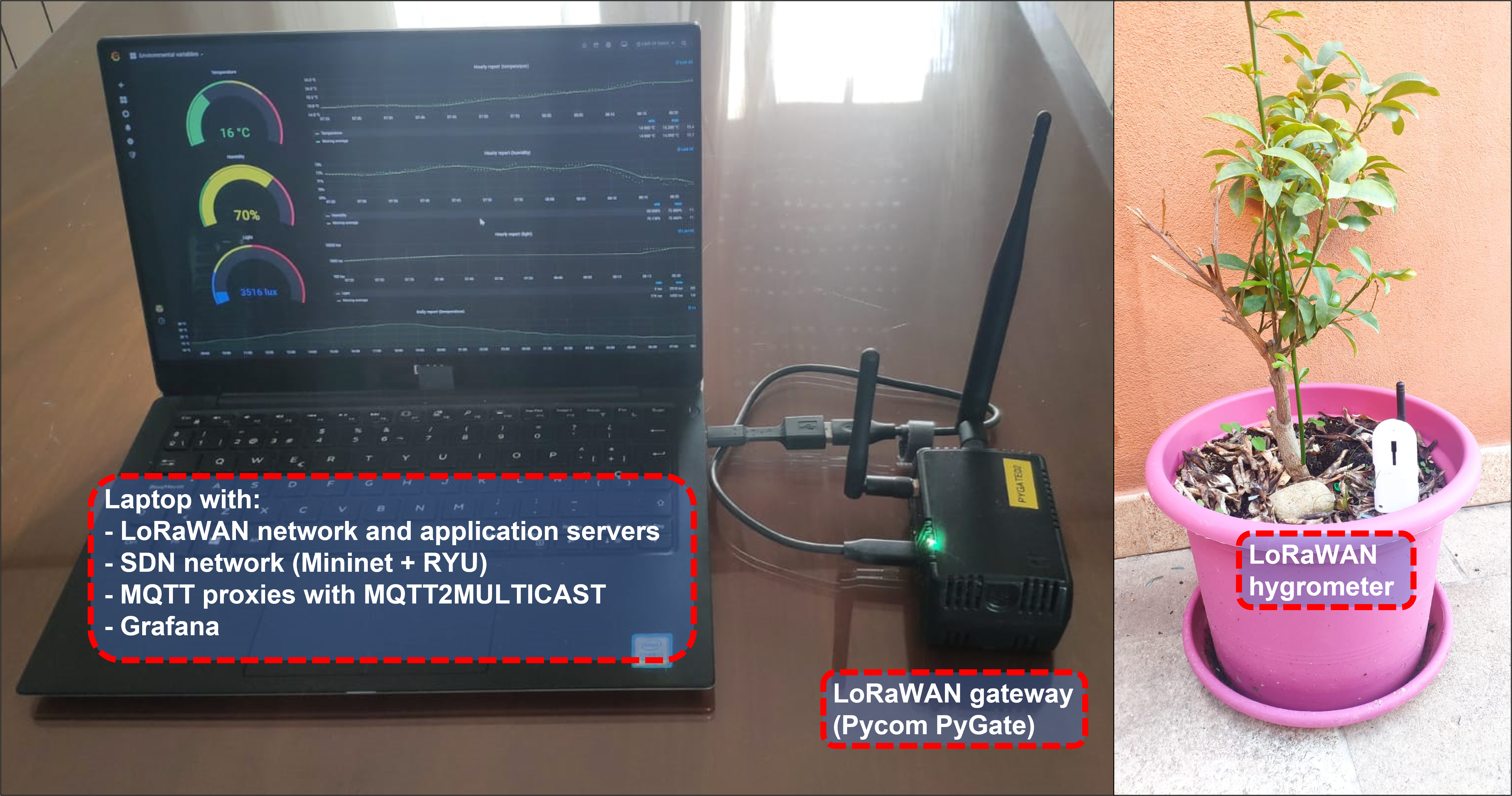


Collision Avoidance Resource Allocation repository for LoRaWAN devices
Micropython code for Pycom's FiPy, to implement the device's part for the paper "Collision Avoidance Resource Allocation for LoRaWAN". Available here. The following picture presents the testbed used to improve the LoRaWAN network capacity.
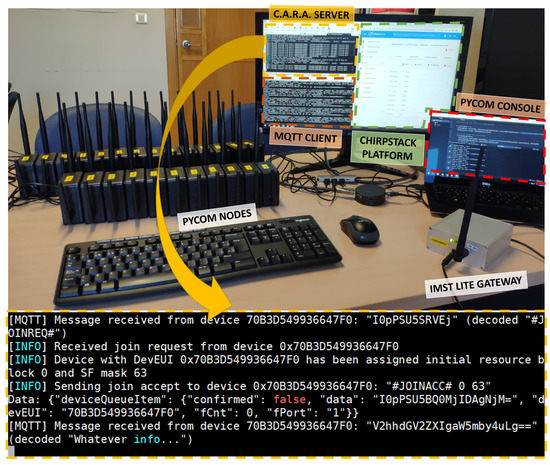

A contention mechanism to allow multimedia transmission over LoRa
Micropython code for Pycom's FiPy, to implement a contention mechanism in order to increase the data rate and thus being able to send images over LoRa. In this testbed, a sender takes a picture from a camera and from an SD card and sends it over LoRa to a receiver, which in turn sends it over Wi-Fi to a streaming server. This allows to send low-resolution images or low-quality videos over LoRa devices, which may be useful in many situations. Current tests show that an image of 10KB can be sent in around 4-6 seconds without contention and around 10-12 seconds with contention. The repository with the code will be made available here once this work is published. The following picture presents the testbed. You can check how the testbed works on the following videos, using contention here and without contention here.
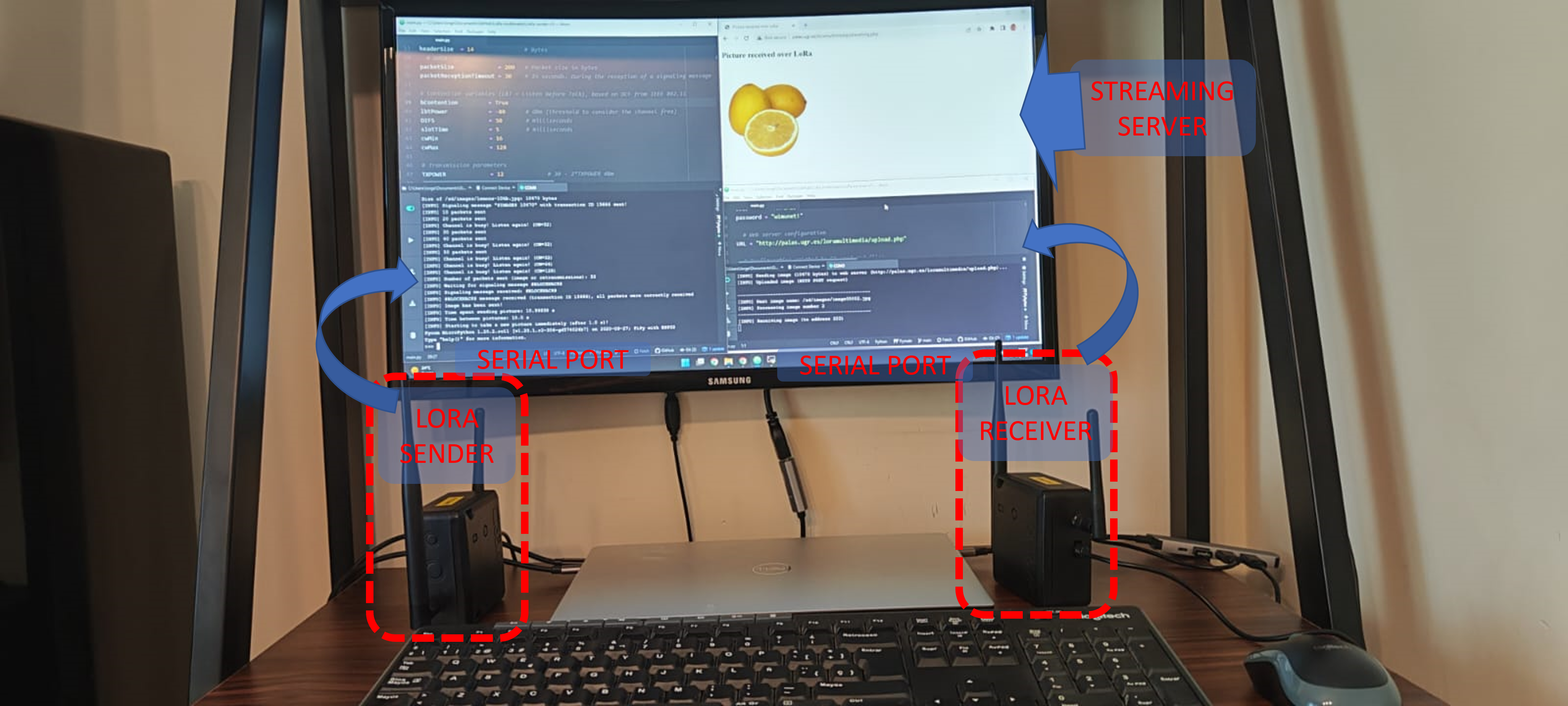

Other repositories
Other repositories related to the project, to create a LoRaWAN network and to control different types of LoRaWAN nodes:
- LoRaWAN network using Pycom gateway (PyGate) and ChirpStack platform or The Things Networks: repository
- TTGO T-Beam Tracker for The Things Network: repository
- LoRaWAN node TTGO LoRa32, using ABP (activation by personalization): repository
- LilyGO T-HiGrow-LoRa-Shield TTN & Cayenne: repository
- LilyGO HiGrow using Wi-Fi: repository
Dissemination activities
Special Issue "5G and Low Power Wide Area Networks for the IoT"


We are looking for original contributions on topics related to 5G and LPWAN technologies applied to the Internet of Things for the Special Issue of Electronics (Q2) "5G and Low Power Wide Area Networks for the IoT". More information here. The deadline for manuscript submissions is 31 Jan. 2022.
SI "Automation and Learning in MEC and Cloud Systems"

We are looking for original contributions on topics related to advances in the development, testing, practical implementations, and modeling of smart ecosystems for 5G and beyond, formed by a set of new procedures, algorithms, technologies, and mathematical tools for advanced system configuration and automation that leads to the zero-touch paradigm. More information here. Deadline is 15 Nov. 2021.
Thesis
Related ongoing Ph.D. thesis
-
Multi-connectivity solutions for 5G/6G networks
Ongoing.
"Multi-connectivity solutions for 5G/6G networks", Felix Delgado-Ferro, University of Granada
close
@PhdThesis{thesisdelgado,
author = {Felix Delgado-Ferro},
director = {Jorge Navarro-Ortiz and Juan M. Lopez-Soler},
title = {Multi-connectivity solutions for 5G/6G networks},
institution = {University of Granada},
type = {phdthesis},
project = {5gclarity|true5g|artemis|premonition|6gchronos|6ginspire},
note = "ongoing"
}
close
-
Optimization and orchestration of LoRaWAN networks
Ongoing.
"Optimization and orchestration of LoRaWAN networks", Natalia Chinchilla-Romero, University of Granada
close
@PhdThesis{thesisnatalia,
author = {Natalia Chinchilla-Romero},
director = {Jorge Navarro-Ortiz},
title = {Optimization and orchestration of LoRaWAN networks},
institution = {University of Granada},
type = {phdthesis},
project = {5gclarity|true5g|artemis|premonition|6gchronos|6ginspire},
note = "ongoing"
}
close
Related B.Sc. and M.Sc. thesis
-
Network slicing for the radio access network in LoRaWAN
Defended on July 2022.
"Network slicing for the radio access network in LoRaWAN", Martin Torres-Antunez, 2022
close
@mastersthesis{martin_2022,
author = {Martin Torres-Antunez},
director = {Jorge Navarro-Ortiz},
title = {Network slicing for the radio access network in LoRaWAN},
school = {Higher Technical School of Informatics and Telecommunications, University of Granada},
type = {Bachelor thesis},
degree = {degree on Telecommunications Engineering},
year = 2022,
month = July,
project = {artemis|premonition},
pdf = {https://wpd.ugr.es/~jorgenavarro/thesis/2022_TFG_MartinTorresAntunez.pdf}
}
close
-
MQTT optimization for LoRaWAN networks
Defended on Sept. 2021.
"MQTT optimization for LoRaWAN networks", Ricardo Cortes-Nunez, 2021
close
@mastersthesis{cortes_2021,
author = {Ricardo Cortes-Nunez},
director = {Jorge Navarro-Ortiz},
title = {MQTT optimization for LoRaWAN networks},
school = {Higher Technical School of Informatics and Telecommunications, University of Granada},
type = {Bachelor thesis},
degree = {degree on Telecommunications Engineering},
year = 2021,
month = Sept.,
project = {artemis|premonition},
pdf = {https://wpd.ugr.es/~jorgenavarro/thesis/2021_TFG_RicardoCortesNunez.pdf}
}
close
-
Machine Learning (ML) algorithms for LoRaWAN devices
Defended on Sept. 2021.
"Machine Learning (ML) algorithms for LoRaWAN devices", Pablo Roas-Domingo, 2021
close
@mastersthesis{roas_2021,
author = {Pablo Roas-Domingo},
director = {Jorge Navarro-Ortiz},
title = {Machine Learning (ML) algorithms for LoRaWAN devices},
school = {Higher Technical School of Informatics and Telecommunications, University of Granada},
type = {M.Sc. thesis},
degree = {M.Sc. Telecommunications Engineering},
year = 2021,
month = Sept.,
project = {artemis|premonition},
pdf = {https://wpd.ugr.es/~jorgenavarro/thesis/2021_TFM_PabloRoasDomingo.pdf}
}
close
-
Improving LoRaWAN networks performance
Defended on July 2021.
"Improving LoRaWAN networks performance", Natalia Chinchilla-Romero, 2021
close
@mastersthesis{chinchilla_2021,
author = {Natalia Chinchilla-Romero},
director = {Jorge Navarro-Ortiz},
title = {Improving LoRaWAN networks performance},
school = {Higher Technical School of Informatics and Telecommunications, University of Granada},
type = {M.Sc. thesis},
degree = {M.Sc. Telecommunications Engineering},
year = 2021,
month = July,
project = {artemis|premonition},
pdf = {https://wpd.ugr.es/~jorgenavarro/thesis/2021_TFM_NataliaChinchillaRomero.pdf}
}
close
-
System to interconnect members of an emergency team in scenarios without coverage
Defended on July 2020.
"System to interconnect members of an emergency team in scenarios without coverage", Felix Delgado-Ferro, 2020
close
@mastersthesis{delgado_2020,
author = {Felix Delgado-Ferro},
director = {Jorge Navarro-Ortiz, Juan Jose Ramos-Munoz},
title = {System to interconnect members of an emergency team in scenarios without coverage},
school = {Higher Technical School of Informatics and Telecommunications, University of Granada},
type = {Bachelor thesis},
degree = {degree on Telecommunications Engineering},
year = 2020,
month = July,
project = {true5g|artemis},
pdf = {https://wpd.ugr.es/~jorgenavarro/thesis/2020_TFG_FelixDelgadoFerro.pdf},
note = {Co-directed with J.J. Ramos-Munoz. This thesis obtained the maximum possible mark and was granted the first position in the 8th edition of the B.Sc. Thesis Awards of the Dpt. Signal Theory, Telematics and Communications of the University of Granada in the category of Telematics Engineering. In addition, it was granted the second position (“accesit”) in the Ingenio Awards 2020 from the Andalusian Official Association of B.Sc. Telecommunications Engineers.}
}
close
Publications
Journals
-
A LoRaWAN Architecture for Communications in Areas without Coverage: Design and Pilot Trials
Electronics, 11 (5), 2022, DOI: 10.3390/electronics11050804. (IF=2.9, Q2)
"A LoRaWAN Architecture for Communications in Areas without Coverage: Design and Pilot Trials", Felix Delgado-Ferro, Jorge Navarro-Ortiz, Natalia Chinchilla-Romero, Juan Jose Ramos-Munoz, Electronics, 11 (5), 2022. DOI: 10.3390/electronics11050804
close
This article proposes a system based on a long-distance communications system with low economic and energy costs that allows connectivity to be carried out independently from the existing cellular coverage in the area. In addition, it describes the design, development, implementation and analysis of an Internet of Things (IoT) architecture based on Long-Range Wide-Area Network (LoRaWAN). Moreover, the system has been deployed as a prototype, and the behavior and scope of the system have been analyzed in various real environments: urban, rural and natural. The results obtained from the analysis show that the system is suitable for working in areas without coverage such as mountains.
close
@Article{electronics11050804,
AUTHOR = {Delgado-Ferro, Felix and Navarro-Ortiz, Jorge and Chinchilla-Romero, Natalia and Ramos-Munoz, Juan Jose},
TITLE = {A LoRaWAN Architecture for Communications in Areas without Coverage: Design and Pilot Trials},
JOURNAL = {Electronics},
VOLUME = {11},
YEAR = {2022},
NUMBER = {5},
ARTICLE-NUMBER = {804},
URL = {https://www.mdpi.com/2079-9292/11/5/804},
ISSN = {2079-9292},
ABSTRACT = {This article proposes a system based on a long-distance communications system with low economic and energy costs that allows connectivity to be carried out independently from the existing cellular coverage in the area. In addition, it describes the design, development, implementation and analysis of an Internet of Things (IoT) architecture based on Long-Range Wide-Area Network (LoRaWAN). Moreover, the system has been deployed as a prototype, and the behavior and scope of the system have been analyzed in various real environments: urban, rural and natural. The results obtained from the analysis show that the system is suitable for working in areas without coverage such as mountains.},
DOI = {10.3390/electronics11050804},
impact = {(IF=2.9, Q2)},
project = {6gchronos|true5g|artemis|premonition}
}
close
-
A LoRaWAN Network Architecture with MQTT2MULTICAST
Electronics, 11 (6), 2022, DOI: 10.3390/electronics11060872. (IF=2.9, Q2)
"A LoRaWAN Network Architecture with MQTT2MULTICAST", Jorge Navarro-Ortiz, Natalia Chinchilla-Romero, Felix Delgado-Ferro, Juan Jose Ramos-Munoz, Electronics, 11 (6), 2022. DOI: 10.3390/electronics11060872
close
In this work, an architecture for IoT networks oriented towards environmental sustainability is presented. Due to the suitability of its characteristics in terms of coverage, power and support of a large number of devices, an enhanced LoRaWAN network has been chosen as the basis for this proposal. The architecture is completed with the virtualization of the different LoRaWAN network entities and the usage of a software-defined network for their interconnection. The publication and subscription to environmental data is carried out by using the MQTT protocol. MQTT has been optimized thanks to the use of the SDN network and the use of edge computing resources, which allows multicasting of published data. Thanks to our developed MQTT2MULTICAST protocol, latency is improved by approx. 90% and the traffic load within the SDN network is reduced by 55%. An scalability analysis shows that this solution is able to support tens of thousands of LoRaWAN gateways. The proposed architecture has been implemented using commercial equipment as a proof of concept.
close
@Article{electronics11060872,
AUTHOR = {Navarro-Ortiz, Jorge and Chinchilla-Romero, Natalia and Delgado-Ferro, Felix and Ramos-Munoz, Juan Jose},
TITLE = {A LoRaWAN Network Architecture with MQTT2MULTICAST},
JOURNAL = {Electronics},
VOLUME = {11},
YEAR = {2022},
NUMBER = {6},
ARTICLE-NUMBER = {872},
URL = {https://www.mdpi.com/2079-9292/11/6/872},
ISSN = {2079-9292},
ABSTRACT = {In this work, an architecture for IoT networks oriented towards environmental sustainability is presented. Due to the suitability of its characteristics in terms of coverage, power and support of a large number of devices, an enhanced LoRaWAN network has been chosen as the basis for this proposal. The architecture is completed with the virtualization of the different LoRaWAN network entities and the usage of a software-defined network for their interconnection. The publication and subscription to environmental data is carried out by using the MQTT protocol. MQTT has been optimized thanks to the use of the SDN network and the use of edge computing resources, which allows multicasting of published data. Thanks to our developed MQTT2MULTICAST protocol, latency is improved by approx. 90% and the traffic load within the SDN network is reduced by 55%. An scalability analysis shows that this solution is able to support tens of thousands of LoRaWAN gateways. The proposed architecture has been implemented using commercial equipment as a proof of concept.},
DOI = {10.3390/electronics11060872},
impact = {(IF=2.9, Q2)},
project = {6gchronos|true5g|artemis|premonition}
}
close
-
Collision Avoidance Resource Allocation for LoRaWAN
Sensors, 21 (4), 2 2021, DOI: 10.3390/s21041218. (IF=3.576, Q2)
"Collision Avoidance Resource Allocation for LoRaWAN", Natalia Chinchilla-Romero, Jorge Navarro-Ortiz, Pablo Munoz, Pablo Ameigeiras, Sensors, 21 (4), 2021. DOI: 10.3390/s21041218
close
The number of connected IoT devices is significantly increasing and it is expected to reach more than two dozens of billions of IoT connections in the coming years. Low Power Wide Area Networks (LPWAN) have become very relevant for this new paradigm due to features such as large coverage and low power consumption. One of the most appealing technologies among these networks is LoRaWAN. Although it may be considered as one of the most mature LPWAN platforms, there are still open gaps such as its capacity limitations. For this reason, this work proposes a collision avoidance resource allocation algorithm named the Collision Avoidance Resource Allocation (CARA) algorithm with the objective of significantly increase system capacity. CARA leverages the multichannel structure and the orthogonality of spreading factors in LoRaWAN networks to avoid collisions among devices. Simulation results show that, assuming ideal radio link conditions, our proposal outperforms in 95.2% the capacity of a standard LoRaWAN network and increases the capacity by almost 40% assuming a realistic propagation model. In addition, it has been verified that CARA devices can coexist with LoRaWAN traditional devices, thus allowing the simultaneous transmissions of both types of devices. Moreover, a proof-of-concept has been implemented using commercial equipment in order to check the feasibility and the correct operation of our solution.
close
@ARTICLE{s21041218,
AUTHOR = {Chinchilla-Romero, Natalia and Navarro-Ortiz, Jorge and Munoz, Pablo and Ameigeiras, Pablo},
TITLE = {Collision Avoidance Resource Allocation for {LoRaWAN}},
JOURNAL = {Sensors},
VOLUME = {21},
YEAR = {2021},
month=2,
NUMBER = {4},
ARTICLE-NUMBER = {1218},
ISSN = {1424-8220},
ABSTRACT = {The number of connected IoT devices is significantly increasing and it is expected to reach more than two dozens of billions of IoT connections in the coming years. Low Power Wide Area Networks (LPWAN) have become very relevant for this new paradigm due to features such as large coverage and low power consumption. One of the most appealing technologies among these networks is {LoRaWAN}. Although it may be considered as one of the most mature LPWAN platforms, there are still open gaps such as its capacity limitations. For this reason, this work proposes a collision avoidance resource allocation algorithm named the Collision Avoidance Resource Allocation (CARA) algorithm with the objective of significantly increase system capacity. CARA leverages the multichannel structure and the orthogonality of spreading factors in {LoRaWAN} networks to avoid collisions among devices. Simulation results show that, assuming ideal radio link conditions, our proposal outperforms in 95.2% the capacity of a standard {LoRaWAN} network and increases the capacity by almost 40% assuming a realistic propagation model. In addition, it has been verified that CARA devices can coexist with {LoRaWAN} traditional devices, thus allowing the simultaneous transmissions of both types of devices. Moreover, a proof-of-concept has been implemented using commercial equipment in order to check the feasibility and the correct operation of our solution.},
DOI = {10.3390/s21041218},
impact = {(IF=3.576, Q2)},
pdf = {https://digibug.ugr.es/handle/10481/67701},
project = {artemis|5gcity|5gclarity}
}
close
-
A Survey on 5G Usage Scenarios and Traffic Models
IEEE Communications Surveys Tutorials, 22 (2), pp. 905-929, 2 2020, DOI: 10.1109/COMST.2020.2971781. (IF=23.7, Q1)
"A Survey on 5G Usage Scenarios and Traffic Models", J. Navarro-Ortiz, P. Romero-Diaz, S. Sendra, P. Ameigeiras, J. J. Ramos-Munoz, J. M. Lopez-Soler, IEEE Communications Surveys Tutorials, 22 (2), pp. 905-929, 2020. DOI: 10.1109/COMST.2020.2971781
close
@Article{8985528, author={J. {Navarro-Ortiz} and P. {Romero-Diaz} and S. {Sendra} and P. {Ameigeiras} and J. J. {Ramos-Munoz} and J. M. {Lopez-Soler}}, journal={{IEEE} Communications Surveys Tutorials}, title={A Survey on 5G Usage Scenarios and Traffic Models}, year={2020}, month=2, volume={22}, number={2}, pages={905-929}, doi={10.1109/COMST.2020.2971781}, project="artemis|5gclarity|5gcity", impact = {(IF=23.7, Q1)}, pdf={https://digibug.ugr.es/handle/10481/59687}}
close
-
Radio Access Network Slicing Strategies at Spectrum Planning Level in 5G and Beyond
IEEE Access, 8, pp. 79604-79618, 4 2020, DOI: 10.1109/ACCESS.2020.2990802. (IF=3.745, Q1)
"Radio Access Network Slicing Strategies at Spectrum Planning Level in 5G and Beyond", P. Munoz, O. Adamuz-Hinojosa, J. Navarro-Ortiz, O. Sallent, J. Perez-Romero, IEEE Access, 8, pp. 79604-79618, 2020. DOI: 10.1109/ACCESS.2020.2990802
close
@Article{9079548, author={P. {Munoz} and O. {Adamuz-Hinojosa} and J. {Navarro-Ortiz} and O. {Sallent} and J. {Perez-Romero}}, journal={{IEEE} Access}, title={Radio Access Network Slicing Strategies at Spectrum Planning Level in 5G and Beyond}, year={2020}, month=4, volume={8}, number={}, pages={79604-79618}, doi={10.1109/ACCESS.2020.2990802}, project="5gclarity|artemis", impact = {(IF=3.745, Q1)}}
close
Conferences & Workshops
-
WiMuNet's research lines
VI Workshop on QoE, QoS on Multimedia Communications (QQCM'21), 2021.
-
Arquitectura para redes IoT orientada a la sostenibilidad medioambiental (IoT network architecture for environmental sustainability)
XV Jornadas de Ingenieria Telematica (JITEL 2021), 2021.
-
Arquitectura LoRaWAN para entornos sin cobertura (LoRaWAN network architecture for environments without coverage)
XV Jornadas de Ingenieria Telematica (JITEL 2021), 2021.
"Arquitectura LoRaWAN para entornos sin cobertura (LoRaWAN network architecture for environments without coverage)", F. Delgado-Ferro, J. Navarro-Ortiz, N. Chinchilla-Romero, J.J. Ramos-Munoz, "XV Jornadas de Ingenieria Telematica (JITEL 2021)", 2021
close
@INPROCEEDINGS{fdelgado_jitel21b, author={F. {Delgado-Ferro} and J. {Navarro-Ortiz} and N. {Chinchilla-Romero} and J.J. {Ramos-Munoz}}, booktitle={XV Jornadas de Ingenieria Telematica (JITEL 2021)}, title={Arquitectura LoRaWAN para entornos sin cobertura (LoRaWAN network architecture for environments without coverage)}, year={2021}, project = {true5g|artemis}, pdf={https://digibug.ugr.es/handle/10481/71143}}
close
-
Sharing gNB components in RAN slicing: A perspective from 3GPP/NFV standards
2019 IEEE Conference on Standards for Communications and Networking (CSCN), pp. 1-7, October 2019, DOI: 10.1109/CSCN.2019.8931318.
"Sharing gNB components in RAN slicing: A perspective from 3GPP/NFV standards", O. Adamuz-Hinojosa, P. Munoz, P. Ameigeiras, J. M. Lopez-Soler, "2019 IEEE Conference on Standards for Communications and Networking (CSCN)", pp. 1-7, 2019. DOI: 10.1109/CSCN.2019.8931318
close
To implement the next Generation NodeBs (gNBs) that are present in every Radio Access Network (RAN) slice subnet, Network Function Virtualization (NFV) enables the deployment of some of the gNB components as Virtual Networks Functions (VNFs). Deploying individual VNF instances for these components could guarantee the customization of each RAN slice subnet. However, due to the multiplicity of VNFs, the required amount of virtual resources will be greater compared to the case where a single VNF instance carries the aggregated traffic of all the RAN slice subnets. Sharing gNB components between RAN slice subnets could optimize the trade-off between customization, isolation and resource utilization. In this article, we shed light on the key aspects in the Third Generation Partnership Project (3GPP)/NFV standards for sharing gNB components. First, we identify four possible scenarios for sharing gNB components. Then, we analyze the impact of sharing on the customization level of each RAN slice subnet. Later, we determine the main factors that enable isolation between RAN slice subnets. Finally, we propose a 3GPP/NFV-based description model to define the lifecycle management of shared gNB components.
close
@INPROCEEDINGS{8931318, author={O. {Adamuz-Hinojosa} and P. {Munoz} and P. {Ameigeiras} and J. M. {Lopez-Soler}}, booktitle={2019 IEEE Conference on Standards for Communications and Networking (CSCN)}, title={Sharing gNB components in RAN slicing: A perspective from 3GPP/NFV standards}, year={2019}, volume={}, number={}, pages={1-7}, abstract={To implement the next Generation NodeBs (gNBs) that are present in every Radio Access Network (RAN) slice subnet, Network Function Virtualization (NFV) enables the deployment of some of the gNB components as Virtual Networks Functions (VNFs). Deploying individual VNF instances for these components could guarantee the customization of each RAN slice subnet. However, due to the multiplicity of VNFs, the required amount of virtual resources will be greater compared to the case where a single VNF instance carries the aggregated traffic of all the RAN slice subnets. Sharing gNB components between RAN slice subnets could optimize the trade-off between customization, isolation and resource utilization. In this article, we shed light on the key aspects in the Third Generation Partnership Project (3GPP)/NFV standards for sharing gNB components. First, we identify four possible scenarios for sharing gNB components. Then, we analyze the impact of sharing on the customization level of each RAN slice subnet. Later, we determine the main factors that enable isolation between RAN slice subnets. Finally, we propose a 3GPP/NFV-based description model to define the lifecycle management of shared gNB components.}, keywords={3GPP;Computer architecture;Ultra reliable low latency communication;Protocols;Next generation networking;Network function virtualization;3GPP;NFV;RAN slicing;sharing gNB components;description model}, doi={10.1109/CSCN.2019.8931318}, ISSN={2644-3252}, month={October}, project={5gcity|artemis}, pdf={https://digibug.ugr.es/handle/10481/68197}
}
close
Photo Gallery
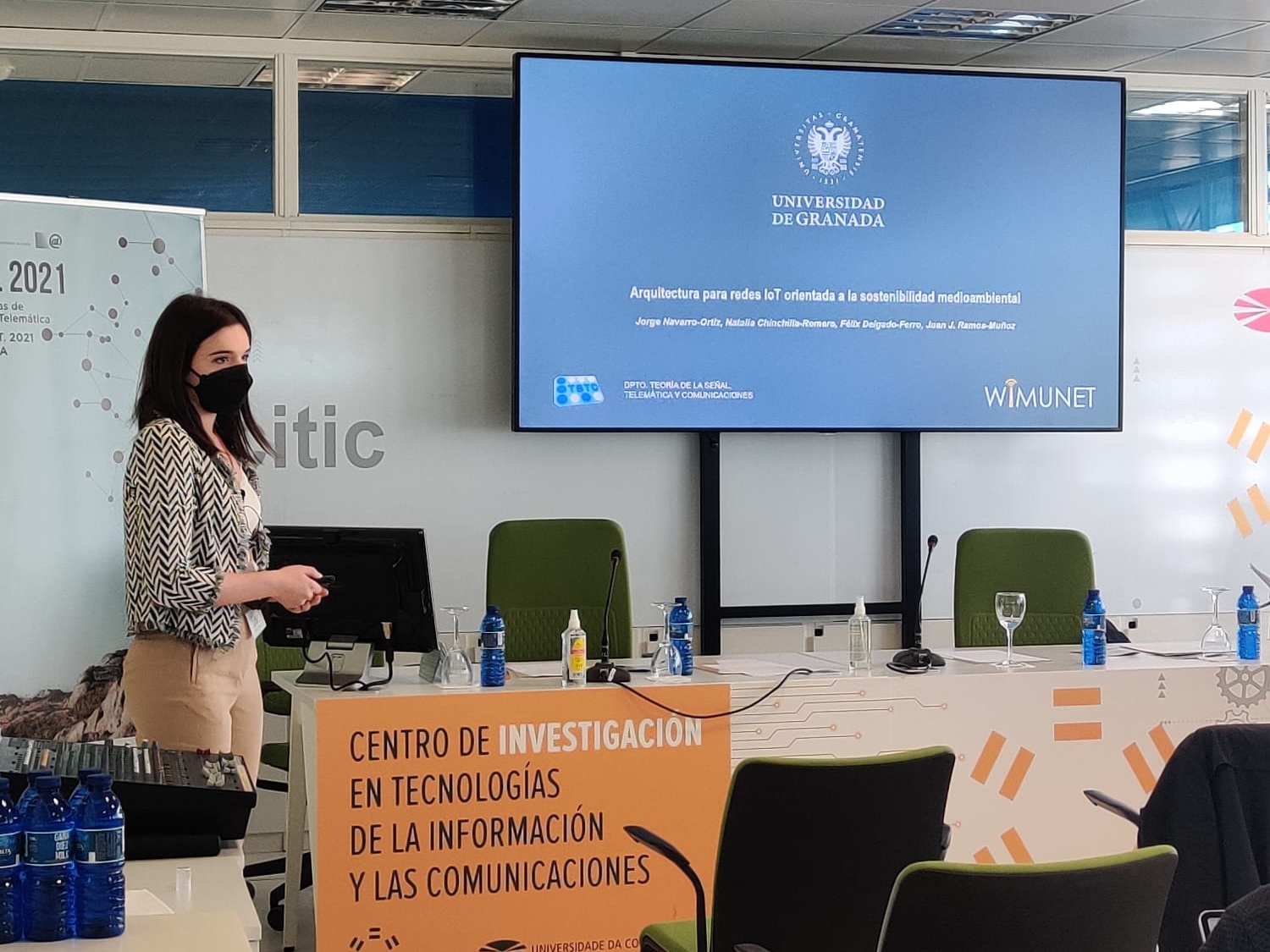
Natalia presenting our paper about the ARTEMIS architecture at JITEL'21
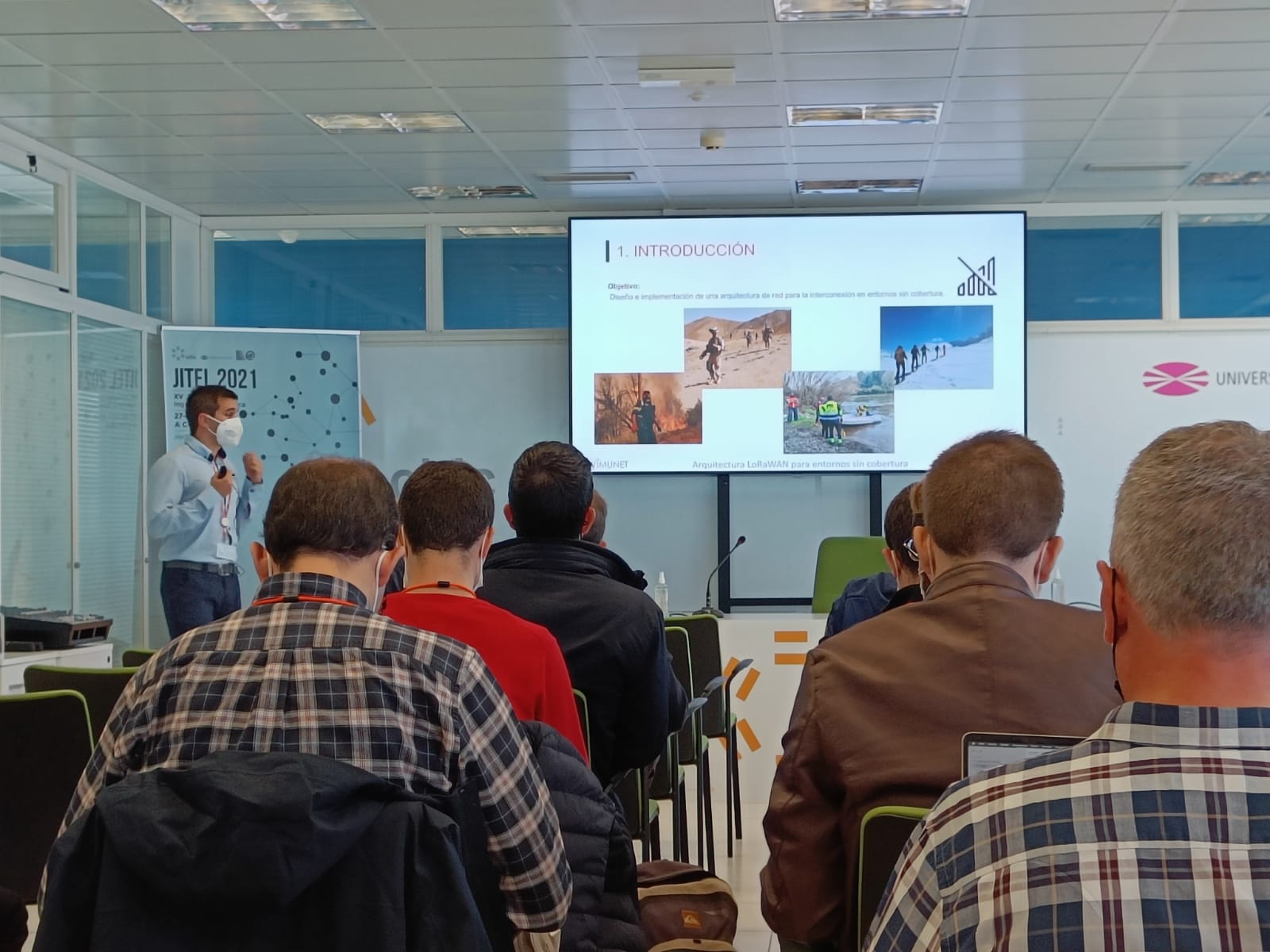
Felix presenting our paper about our architecture for environments without coverage using LoRaWAN at JITEL'21
Multi-connectivity solutions for 5G/6G networksOngoing."Multi-connectivity solutions for 5G/6G networks", Felix Delgado-Ferro, University of Granadaclose@PhdThesis{thesisdelgado, author = {Felix Delgado-Ferro}, director = {Jorge Navarro-Ortiz and Juan M. Lopez-Soler}, title = {Multi-connectivity solutions for 5G/6G networks}, institution = {University of Granada}, type = {phdthesis}, project = {5gclarity|true5g|artemis|premonition|6gchronos|6ginspire}, note = "ongoing" }close@PhdThesis{thesisnatalia, author = {Natalia Chinchilla-Romero}, director = {Jorge Navarro-Ortiz}, title = {Optimization and orchestration of LoRaWAN networks}, institution = {University of Granada}, type = {phdthesis}, project = {5gclarity|true5g|artemis|premonition|6gchronos|6ginspire}, note = "ongoing" }closeRelated B.Sc. and M.Sc. thesis
@mastersthesis{martin_2022, author = {Martin Torres-Antunez}, director = {Jorge Navarro-Ortiz}, title = {Network slicing for the radio access network in LoRaWAN}, school = {Higher Technical School of Informatics and Telecommunications, University of Granada}, type = {Bachelor thesis}, degree = {degree on Telecommunications Engineering}, year = 2022, month = July, project = {artemis|premonition}, pdf = {https://wpd.ugr.es/~jorgenavarro/thesis/2022_TFG_MartinTorresAntunez.pdf} }close@mastersthesis{cortes_2021, author = {Ricardo Cortes-Nunez}, director = {Jorge Navarro-Ortiz}, title = {MQTT optimization for LoRaWAN networks}, school = {Higher Technical School of Informatics and Telecommunications, University of Granada}, type = {Bachelor thesis}, degree = {degree on Telecommunications Engineering}, year = 2021, month = Sept., project = {artemis|premonition}, pdf = {https://wpd.ugr.es/~jorgenavarro/thesis/2021_TFG_RicardoCortesNunez.pdf} }close@mastersthesis{roas_2021, author = {Pablo Roas-Domingo}, director = {Jorge Navarro-Ortiz}, title = {Machine Learning (ML) algorithms for LoRaWAN devices}, school = {Higher Technical School of Informatics and Telecommunications, University of Granada}, type = {M.Sc. thesis}, degree = {M.Sc. Telecommunications Engineering}, year = 2021, month = Sept., project = {artemis|premonition}, pdf = {https://wpd.ugr.es/~jorgenavarro/thesis/2021_TFM_PabloRoasDomingo.pdf} }close@mastersthesis{chinchilla_2021, author = {Natalia Chinchilla-Romero}, director = {Jorge Navarro-Ortiz}, title = {Improving LoRaWAN networks performance}, school = {Higher Technical School of Informatics and Telecommunications, University of Granada}, type = {M.Sc. thesis}, degree = {M.Sc. Telecommunications Engineering}, year = 2021, month = July, project = {artemis|premonition}, pdf = {https://wpd.ugr.es/~jorgenavarro/thesis/2021_TFM_NataliaChinchillaRomero.pdf} }close@mastersthesis{delgado_2020, author = {Felix Delgado-Ferro}, director = {Jorge Navarro-Ortiz, Juan Jose Ramos-Munoz}, title = {System to interconnect members of an emergency team in scenarios without coverage}, school = {Higher Technical School of Informatics and Telecommunications, University of Granada}, type = {Bachelor thesis}, degree = {degree on Telecommunications Engineering}, year = 2020, month = July, project = {true5g|artemis}, pdf = {https://wpd.ugr.es/~jorgenavarro/thesis/2020_TFG_FelixDelgadoFerro.pdf}, note = {Co-directed with J.J. Ramos-Munoz. This thesis obtained the maximum possible mark and was granted the first position in the 8th edition of the B.Sc. Thesis Awards of the Dpt. Signal Theory, Telematics and Communications of the University of Granada in the category of Telematics Engineering. In addition, it was granted the second position (“accesit”) in the Ingenio Awards 2020 from the Andalusian Official Association of B.Sc. Telecommunications Engineers.} }closePublications
Journals
@Article{electronics11050804, AUTHOR = {Delgado-Ferro, Felix and Navarro-Ortiz, Jorge and Chinchilla-Romero, Natalia and Ramos-Munoz, Juan Jose}, TITLE = {A LoRaWAN Architecture for Communications in Areas without Coverage: Design and Pilot Trials}, JOURNAL = {Electronics}, VOLUME = {11}, YEAR = {2022}, NUMBER = {5}, ARTICLE-NUMBER = {804}, URL = {https://www.mdpi.com/2079-9292/11/5/804}, ISSN = {2079-9292}, ABSTRACT = {This article proposes a system based on a long-distance communications system with low economic and energy costs that allows connectivity to be carried out independently from the existing cellular coverage in the area. In addition, it describes the design, development, implementation and analysis of an Internet of Things (IoT) architecture based on Long-Range Wide-Area Network (LoRaWAN). Moreover, the system has been deployed as a prototype, and the behavior and scope of the system have been analyzed in various real environments: urban, rural and natural. The results obtained from the analysis show that the system is suitable for working in areas without coverage such as mountains.}, DOI = {10.3390/electronics11050804}, impact = {(IF=2.9, Q2)}, project = {6gchronos|true5g|artemis|premonition} }close@Article{electronics11060872, AUTHOR = {Navarro-Ortiz, Jorge and Chinchilla-Romero, Natalia and Delgado-Ferro, Felix and Ramos-Munoz, Juan Jose}, TITLE = {A LoRaWAN Network Architecture with MQTT2MULTICAST}, JOURNAL = {Electronics}, VOLUME = {11}, YEAR = {2022}, NUMBER = {6}, ARTICLE-NUMBER = {872}, URL = {https://www.mdpi.com/2079-9292/11/6/872}, ISSN = {2079-9292}, ABSTRACT = {In this work, an architecture for IoT networks oriented towards environmental sustainability is presented. Due to the suitability of its characteristics in terms of coverage, power and support of a large number of devices, an enhanced LoRaWAN network has been chosen as the basis for this proposal. The architecture is completed with the virtualization of the different LoRaWAN network entities and the usage of a software-defined network for their interconnection. The publication and subscription to environmental data is carried out by using the MQTT protocol. MQTT has been optimized thanks to the use of the SDN network and the use of edge computing resources, which allows multicasting of published data. Thanks to our developed MQTT2MULTICAST protocol, latency is improved by approx. 90% and the traffic load within the SDN network is reduced by 55%. An scalability analysis shows that this solution is able to support tens of thousands of LoRaWAN gateways. The proposed architecture has been implemented using commercial equipment as a proof of concept.}, DOI = {10.3390/electronics11060872}, impact = {(IF=2.9, Q2)}, project = {6gchronos|true5g|artemis|premonition} }close@ARTICLE{s21041218, AUTHOR = {Chinchilla-Romero, Natalia and Navarro-Ortiz, Jorge and Munoz, Pablo and Ameigeiras, Pablo}, TITLE = {Collision Avoidance Resource Allocation for {LoRaWAN}}, JOURNAL = {Sensors}, VOLUME = {21}, YEAR = {2021}, month=2, NUMBER = {4}, ARTICLE-NUMBER = {1218}, ISSN = {1424-8220}, ABSTRACT = {The number of connected IoT devices is significantly increasing and it is expected to reach more than two dozens of billions of IoT connections in the coming years. Low Power Wide Area Networks (LPWAN) have become very relevant for this new paradigm due to features such as large coverage and low power consumption. One of the most appealing technologies among these networks is {LoRaWAN}. Although it may be considered as one of the most mature LPWAN platforms, there are still open gaps such as its capacity limitations. For this reason, this work proposes a collision avoidance resource allocation algorithm named the Collision Avoidance Resource Allocation (CARA) algorithm with the objective of significantly increase system capacity. CARA leverages the multichannel structure and the orthogonality of spreading factors in {LoRaWAN} networks to avoid collisions among devices. Simulation results show that, assuming ideal radio link conditions, our proposal outperforms in 95.2% the capacity of a standard {LoRaWAN} network and increases the capacity by almost 40% assuming a realistic propagation model. In addition, it has been verified that CARA devices can coexist with {LoRaWAN} traditional devices, thus allowing the simultaneous transmissions of both types of devices. Moreover, a proof-of-concept has been implemented using commercial equipment in order to check the feasibility and the correct operation of our solution.}, DOI = {10.3390/s21041218}, impact = {(IF=3.576, Q2)}, pdf = {https://digibug.ugr.es/handle/10481/67701}, project = {artemis|5gcity|5gclarity} }close@Article{8985528, author={J. {Navarro-Ortiz} and P. {Romero-Diaz} and S. {Sendra} and P. {Ameigeiras} and J. J. {Ramos-Munoz} and J. M. {Lopez-Soler}}, journal={{IEEE} Communications Surveys Tutorials}, title={A Survey on 5G Usage Scenarios and Traffic Models}, year={2020}, month=2, volume={22}, number={2}, pages={905-929}, doi={10.1109/COMST.2020.2971781}, project="artemis|5gclarity|5gcity", impact = {(IF=23.7, Q1)}, pdf={https://digibug.ugr.es/handle/10481/59687}}close@Article{9079548, author={P. {Munoz} and O. {Adamuz-Hinojosa} and J. {Navarro-Ortiz} and O. {Sallent} and J. {Perez-Romero}}, journal={{IEEE} Access}, title={Radio Access Network Slicing Strategies at Spectrum Planning Level in 5G and Beyond}, year={2020}, month=4, volume={8}, number={}, pages={79604-79618}, doi={10.1109/ACCESS.2020.2990802}, project="5gclarity|artemis", impact = {(IF=3.745, Q1)}}closeConferences & Workshops
@INPROCEEDINGS{fdelgado_jitel21b, author={F. {Delgado-Ferro} and J. {Navarro-Ortiz} and N. {Chinchilla-Romero} and J.J. {Ramos-Munoz}}, booktitle={XV Jornadas de Ingenieria Telematica (JITEL 2021)}, title={Arquitectura LoRaWAN para entornos sin cobertura (LoRaWAN network architecture for environments without coverage)}, year={2021}, project = {true5g|artemis}, pdf={https://digibug.ugr.es/handle/10481/71143}}close@INPROCEEDINGS{8931318, author={O. {Adamuz-Hinojosa} and P. {Munoz} and P. {Ameigeiras} and J. M. {Lopez-Soler}}, booktitle={2019 IEEE Conference on Standards for Communications and Networking (CSCN)}, title={Sharing gNB components in RAN slicing: A perspective from 3GPP/NFV standards}, year={2019}, volume={}, number={}, pages={1-7}, abstract={To implement the next Generation NodeBs (gNBs) that are present in every Radio Access Network (RAN) slice subnet, Network Function Virtualization (NFV) enables the deployment of some of the gNB components as Virtual Networks Functions (VNFs). Deploying individual VNF instances for these components could guarantee the customization of each RAN slice subnet. However, due to the multiplicity of VNFs, the required amount of virtual resources will be greater compared to the case where a single VNF instance carries the aggregated traffic of all the RAN slice subnets. Sharing gNB components between RAN slice subnets could optimize the trade-off between customization, isolation and resource utilization. In this article, we shed light on the key aspects in the Third Generation Partnership Project (3GPP)/NFV standards for sharing gNB components. First, we identify four possible scenarios for sharing gNB components. Then, we analyze the impact of sharing on the customization level of each RAN slice subnet. Later, we determine the main factors that enable isolation between RAN slice subnets. Finally, we propose a 3GPP/NFV-based description model to define the lifecycle management of shared gNB components.}, keywords={3GPP;Computer architecture;Ultra reliable low latency communication;Protocols;Next generation networking;Network function virtualization;3GPP;NFV;RAN slicing;sharing gNB components;description model}, doi={10.1109/CSCN.2019.8931318}, ISSN={2644-3252}, month={October}, project={5gcity|artemis}, pdf={https://digibug.ugr.es/handle/10481/68197} }closePhoto Gallery

Natalia presenting our paper about the ARTEMIS architecture at JITEL'21

Felix presenting our paper about our architecture for environments without coverage using LoRaWAN at JITEL'21

